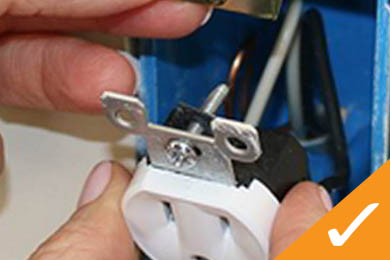Electrical
Electrical Installation and Repair
Because of the safety risks involved with electricity, most electrical work is best left to the professionals. Give us a call or email us and let us know how we can help.
Common Electrical Problems:
Because of the safety risks involved, most electrical work is best left to the professionals. However, there are simple steps you can take before calling us to see if there is an easy and safe fix.
Power Surges:
Due to inherent risks with electricity there are many features built in to cut power at the first sign of a problem. As a result, one of the most common reasons for sudden loss of power in a home is that a safety trigger has been tripped.
If you lose power in a room or part of your home, but not the whole house, there are several areas to look to determine what may be the cause. The first culprit is that a breaker switch has been tripped. If your home has a basement, the breaker box will often be found there (sometimes called a fuse box). They can also be found in utility closets or hallways. If the individual breaker switches are not labeled, you should turn each off one-by-one and identify which areas they correlate to. This is best done as a two-person job. Also, our electricians can track down and label all of your circuits. No matter what, you should know where your breaker box is and have each labeled in the case of an emergency.
If a switch is tripped it will be a position different than the rest. Move it completely to the “off” side then back to “on” position. It should stay in the “on” position and your electricity should resume. However, if it keeps popping back into off mode, it means that something is still overloading the circuit when you turn it on. Make sure that all objects plugged in in that area are off and try again. If you still cannot get it to turn on, call an electrician.
Electrical Outlet Does Not Work:
If you only lose power in one outlet box that is a GFCI (Ground-Fault Circuit Interrupter) that has a test and reset button in the center, check to make sure the reset button has not popped out. These types of outlets are common in areas that contain moisture, such as a bathroom, or that handle large loads, such as with electrical appliances in kitchens. If the reset button does not fix your outage, move on to the breaker box.
If there is blackening around any outlets, cease use and unplug everything immediately. Even if one plug is working, you must replace the entire outlet immediately to avoid a possible fire or wire damage.
Electrical Outlet Sparks:
While it is unnerving to see a spark fly from an outlet, occasionally sudden power draw will create a quick spark that then stops.
However, if there is too much heat in an outlet it can melt the insulation that surrounds the wires. Exposed wires are a serious fire hazard. When a connection is made, the electrons can leap to the wrong area and cause a serious spark, creating a short circuit and a potential fire, even inside the wall where it cannot be seen.
Flickering Lights:
This is a good sign that you have a poor electrical connection that may eventually lead to a broken connection. Our electricians will be able to find the source of the problem and correct it.
Recessed Lighting Turning Off:
Most recessed fixtures contain a mechanism to prevent them from overheating due to the nature of where they are installed. The fixture will turn itself off to cool down, and once it is safe it will resume. The most common problem of the overheating is that the bulb in the fixture is too high of a wattage for the fixture. Change to a lower wattage or a different type of bulb such as LED that is cool running.
Appliances Causing Breaker to Trip:
High-wattage items running at the same time can overload the circuit, such as a clothes dryer and a microwave running on the same circuit. To solve this problem, move the appliances to a different circuit or have an electrician install different circuits in the same area to ensure you will not overload.
Frequent Light Bulb Burnouts:
This again is likely caused by using a bulb that is too many watts for the fixture that it is placed in. All fixtures have a maximum rating labeled on them. Check this against the bulbs that you are using. Again, changing to bulbs such as CFL (compact fluorescent) or LED have the same illumination but at a much lower wattage. Not only will you not burn out your bulbs, but you will save on your energy bill.
Electrical Inspector’s Checklist
When you hire an electrical inspector, there is a definitive list of what needs to be checked to make sure your home is safe:
Electric Meter:
The electrician should check the electric meter for defects such as loose installation, broken meter seals, rust at the bottom of the box and anything that could indicate the presence of water. Water can sometimes enter through the service entrance causing rust or damage to the main panel.
Wires:
Outside wires needs to be inspected for any sign of fraying or damage. Unprotected wires anywhere inside the home, especially in attics, basements and crawl spaces, need to be searched for and listed. Wires resting on heat ducts or pipes as well create an unsafe situation and need to be reported.
Main Panel Box:
The electrical panel houses circuit breakers which are designed to prevent electric current from exceeding safe levels. Insufficient clearance, improperly sized circuit breakers, oxidation or corrosion, aluminum branch wiring, overheated components and the presence of moisture can all create a dangerous situation and need to be checked. Inspecting these panels should only be done by professionals.
Ground Fault Circuit Interrupter Outlets:
GFCI outlets should be placed in basements, garages, kitchens, bathrooms ad other areas where there may be a build up of moisture. There are regulations that require this style of outlet in certain area and your electrician should ensure that these are up to code. A qualified electrician can ensure these outlets are wired correctly and test other outlets in the home for looseness or reversed polarity.
Wall Switches:
An electrician should test all wall switches for reversed polarity and ungrounded circuits, looking out for electrical problems. Some of these warning signs can include discolored, loose or damaged switch plates and unsafe wiring.
2025 © DoneRightWorks, LLC. All rights reserved. | Sitemap





